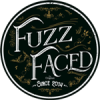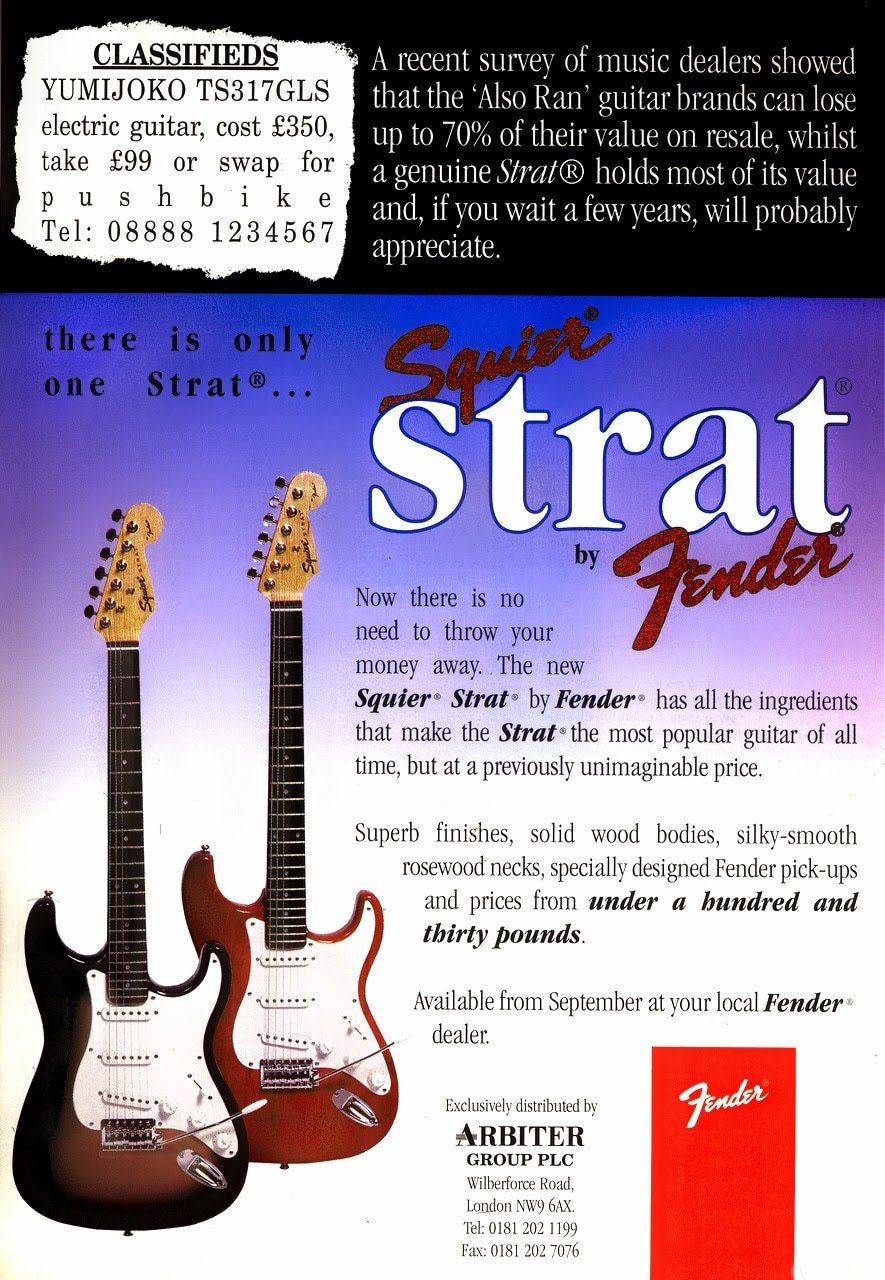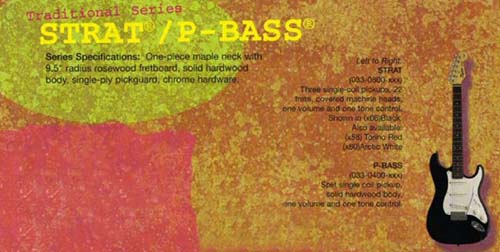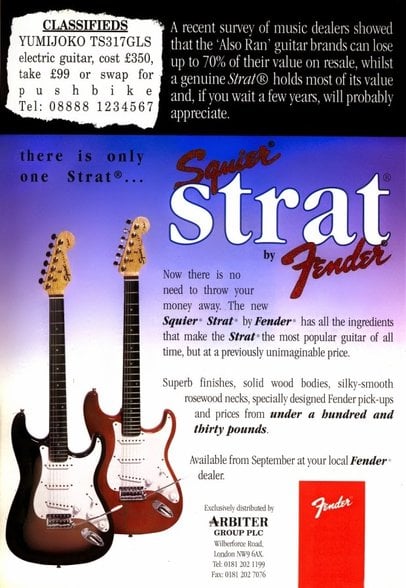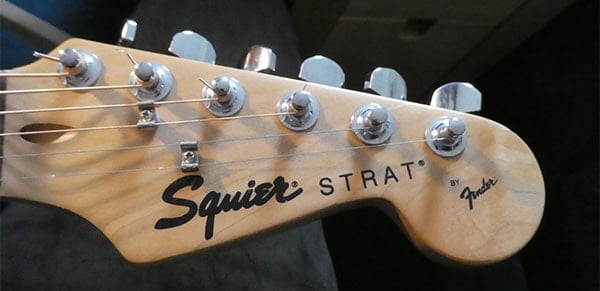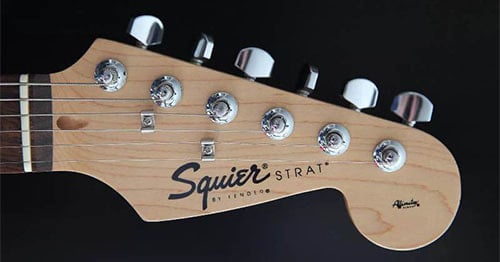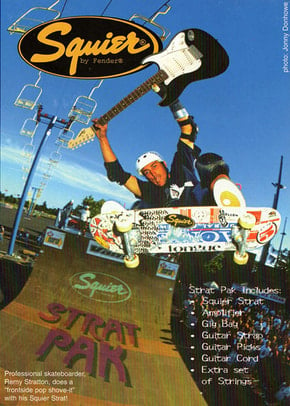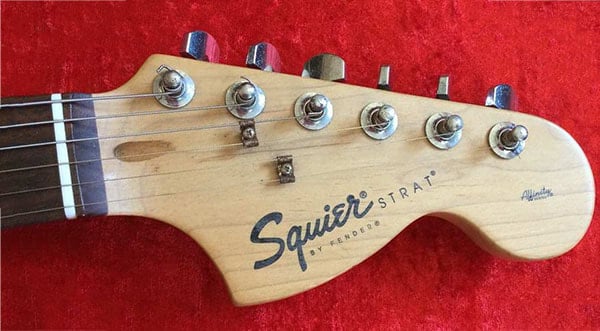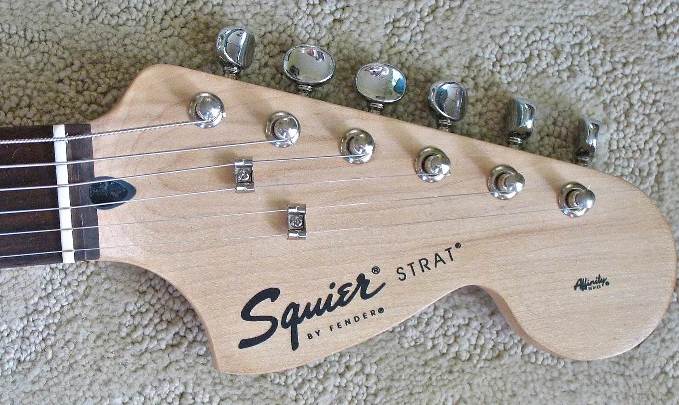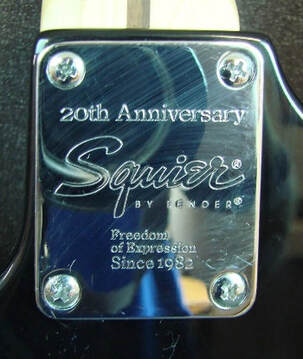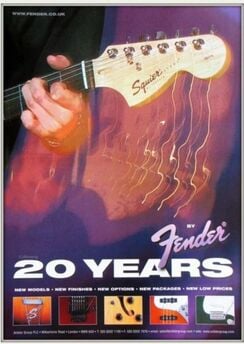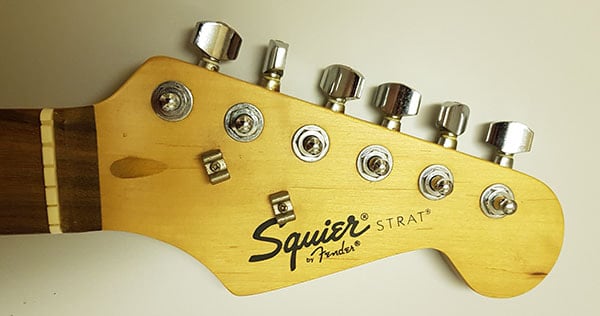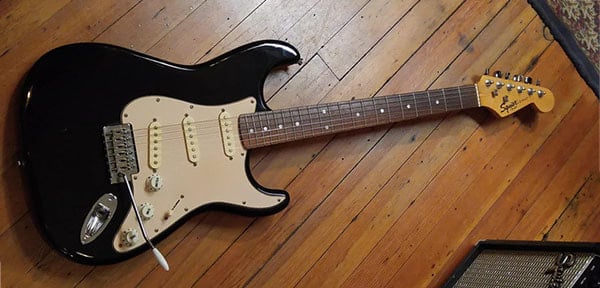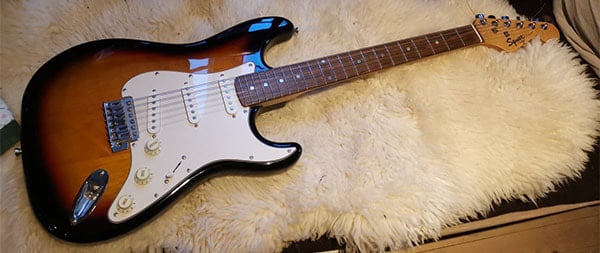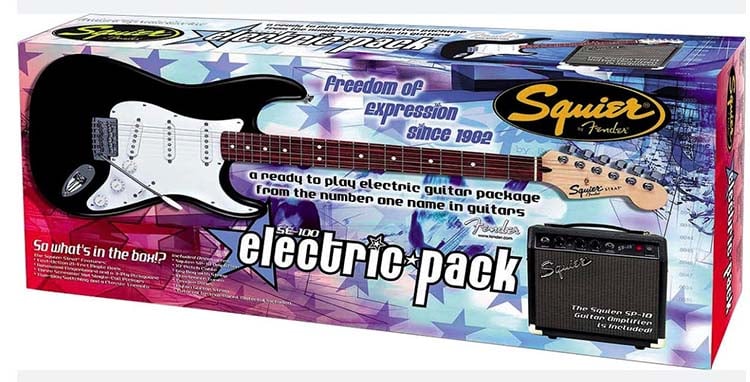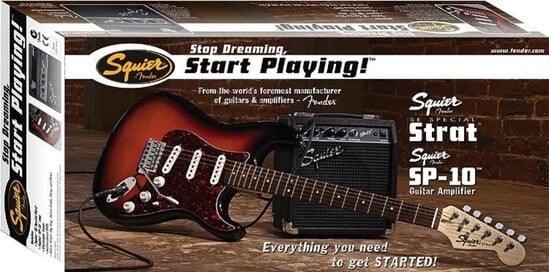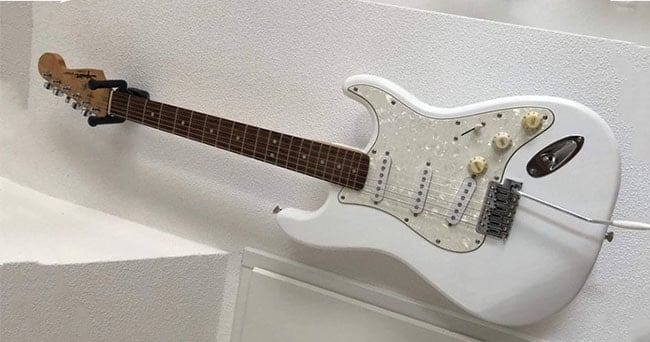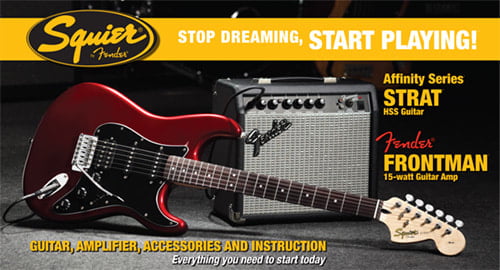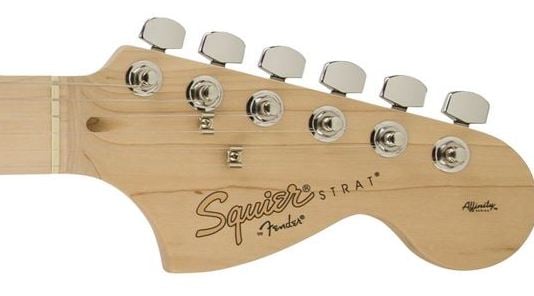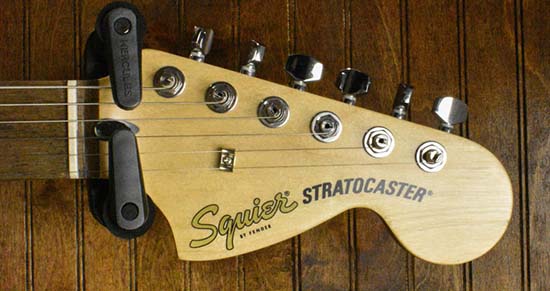Squier Tradition SERIES
|
The first Chinese Bullets could be considered an experiment. If Fender really wanted to revive the Squier brand, it should not, at least for the time being, refer to the cheapest Stratocasters ever, the Bullets.
So, in mid-1996 the Bullets were replaced with the new Squier Tradition Strat (also called "Traditional"), which cost only $239.99. |
Fender was never specific about the wood used for the body of these guitars, as it declared only solid hardwood among its specs. They were only available with a maple neck, devoid of the skunk stripe, with a twenty-two-fret rosewood fingerboard.
|
The Squier Strats had a small headstock with the Black Silkscreen Logo and access to the truss rod with no black insert, while on the back side of the headstock there was always the 1996 anniversary logo.
The pickups were ceramic, the tuners were covered, and the six-screw Synchronous Tremolo had a thinner inertia bar and thin block saddles. The serial number, which began with NC or YN (which stood for “Yako Nineties” because they were built in the Yako factory), was engraved on the neck plate along with the words “MADE IN CHINA” just like the Bullets made in China between 1994 and 1996. In addition, those with the NC serial number also had “MADE IN CHINA” written on the headstock, below the Squier logo. They were available in Black, Torino Red, and Arctic White finishes, in addition to the Brown Sunburst available only for the European market. These Squiers were low-quality guitars, due to the materials used, but the structural standard had improved. The price was ridiculously low, even lower than the highly criticized Korean Squiers, so much so that they prevailed in the fiercely competitive low-budget market. |
THE FIRST AFFINITY STRATS
As early as 1997, the Tradition Series was renamed as the Affinity Series, although the Squier Affinity Strat was still very similar to the earlier Tradition Strat, to the extent that it kept the same model number.
The lettering on the headstock, as small as the lettering on the Tradition, was slightly different. Specifically, the Fender logo on the ball of the headstock was replaced with the words "Affinity SERIES."
Early Affinity Strats had serial numbers beginning with NC or YN on the neck plate, but as early as 1998 a new serial number beginning with CY (which stood for "China Yako"), written on the back side of the headstock, replaced the one engraved on the neck plate.
The lettering on the headstock, as small as the lettering on the Tradition, was slightly different. Specifically, the Fender logo on the ball of the headstock was replaced with the words "Affinity SERIES."
Early Affinity Strats had serial numbers beginning with NC or YN on the neck plate, but as early as 1998 a new serial number beginning with CY (which stood for "China Yako"), written on the back side of the headstock, replaced the one engraved on the neck plate.
THE PAK AND THE NEW AFFINITY STRATS
|
Thanks to the idea of Joe Carducci, then Marketing Manager for Squier, in 1997 Squiers began to be sold in packs, or, as it was rendered in Fender-speak, in Paks.
This could seem obvious now, but it was a very innovative idea: take a cheap guitar, a small amp, a cord, a strap, a gig bag, strings, picks, and a how-to tutor, put them all in a box, and sell it to parents who want to buy the kid an electric guitar but who know nothing about the subject. All at bargain prices. In 2004 the slogan “Stop dreaming, start playing” was successfully used to describe the Squier Strat Pack. The first Squier Stratocasters included in the 1997 Squier Starter Pack were the same Affinity Strats that could be purchased on their own and had a thick body like all other Stratocasters. |
However, as of November 1998, Squier began to differentiate between the Affinity included in the Pak and those that could be purchased separately, but more importantly, the body of all Affinity guitars became slightly smaller, about 40mm thick. The small headstock was replaced with the large headstock, the fretboard was changed from twenty-two to twenty-one frets, the neck width at the nut was reduced to 1.61", die-cast saddles similar to CBS saddles replaced block ones, and the new Baltic Blue finish was added.
The "regular" Affinity Strats were made in China and had a serial number beginning with CY, a rosewood fingerboard, and a single-ply white eight-hole pickguard. They didn’t have the skunk stripe or a black insert truss rod access.
Pak's Affinity Strats were built in the Indonesian Cor-Tek factory, had a maple fretboard, their serial number began with IC, they had a single-ply white eleven-hole pickguard, skunk stripe, and a black insert truss rod access.
Both had the "AFFINITY Series" logo on the ball of the headstock and the words "Crafted in" took the place of "MADE IN" on the back side of the headstock, along with the serial number.
The "regular" Affinity Strats were made in China and had a serial number beginning with CY, a rosewood fingerboard, and a single-ply white eight-hole pickguard. They didn’t have the skunk stripe or a black insert truss rod access.
Pak's Affinity Strats were built in the Indonesian Cor-Tek factory, had a maple fretboard, their serial number began with IC, they had a single-ply white eleven-hole pickguard, skunk stripe, and a black insert truss rod access.
Both had the "AFFINITY Series" logo on the ball of the headstock and the words "Crafted in" took the place of "MADE IN" on the back side of the headstock, along with the serial number.
Both were unveiled at the 1999 NAMM and, at the same time, the Affinity series was expanded with the short scale (22.7”) Squier Mini, which featured twenty frets, only two knobs (volume and tone), and a hard-tail bridge. The Mini was manufactured in Indonesia at the PT Samick plant and, at least initially, had the serial number beginning with IS (which stood for "Indonesia Samick").
APRIL 2000-7/2012
In April 2000 things changed again. The difference remained between Chinese Squiers, sold separately from the Squier Beginner Pack, and Indonesian Squiers, included in the Pak.
However, new finishes and limited editions were added, Standard tuners replaced the cheaper 'covered' ones, but most importantly, the new Squiers had a thinner neck, whose shape was called “fast action.” They were strongly wanted by Keith Brawley, Squier's marketing manager since 2000, so that these guitars would have a completely different profile from all Fenders on the market.
However, new finishes and limited editions were added, Standard tuners replaced the cheaper 'covered' ones, but most importantly, the new Squiers had a thinner neck, whose shape was called “fast action.” They were strongly wanted by Keith Brawley, Squier's marketing manager since 2000, so that these guitars would have a completely different profile from all Fenders on the market.
Interestingly, the neck plate of all Squier guitars built in 2002 bore the inscription “20th anniversary Squier BY FENDER Freedom of Expression Since 1982,” leading many to mistakenly believe that they were dealing with a special model.
Although the body of the Affinity was always thinner than that of other Stratocasters, Squier began to standardize the woods used: the Indonesian Affinity Strats had agathis bodies, while the Chinese ones (therefore excluded from the Pak) had an alder (for the U.S. market) or an agathis body. Also available from 2004 was the Chinese Squier Strat with maple cap fretboards.
Special versions of the Chinese Affinity were manufactured between 2002 and 2004, in Butterscotch Blonde finish with maple fingerboard, black pickguard and plastics (2002), Aztec Gold with maple cap fingerboard (2003), and 2-Tone Sunburst with maple cap fingerboard (8/2003-2005).
Special versions of the Chinese Affinity were manufactured between 2002 and 2004, in Butterscotch Blonde finish with maple fingerboard, black pickguard and plastics (2002), Aztec Gold with maple cap fingerboard (2003), and 2-Tone Sunburst with maple cap fingerboard (8/2003-2005).
Squier SE strat
Squier SE-100
From 2002 to 2012 Squier also began production of Squier “SE” Stratocasters, (not Affinity), which could only be purchased in the pak.
The first was the Squier SE-100, listed in the catalog between August 2002 and March 2007, sold with the Squier SP-10 amplifier. For the first few years there were both some Indonesian SE-100 paks from Samick and Chinese SE-100 paks from AXL. The Indonesian guitars were thinner (40mm) and mostly made between 2002 and 2004, whilst the Chinese SE-100s had a full-size body and made between 2002 and 2007.
The first was the Squier SE-100, listed in the catalog between August 2002 and March 2007, sold with the Squier SP-10 amplifier. For the first few years there were both some Indonesian SE-100 paks from Samick and Chinese SE-100 paks from AXL. The Indonesian guitars were thinner (40mm) and mostly made between 2002 and 2004, whilst the Chinese SE-100s had a full-size body and made between 2002 and 2007.
|
Interestingly, the Squier SE-100 made in China was very similar to the Tradition Strat, but it had 21 frets and an 11-hole pickguard, while the Tradition Strat had 22 frets and an 8-hole pickguard.
The Squier SE-100 headstock was identical to that of the Tradition Strat, therefore it had a Squier Black Silkscreen logo, but did not have the Fender logo on the ball of the headstock. Furthermore, it didn’t have the 1996 anniversary logo and had Standard tuners, while the Tradition had 'covered' tuners. |
A few SE-100s that were manufactured for the European market featured 22 frets and the skunk stripe and were also available in Brown Sunburst and Torino Red, in addition to the more common Black finish.
A common mistake made in dating Chinese SE-100s is to believe that their serial number, printed on a sticker that was attached to the back side of the headstock and began with CAE, referred to the year 2000, but in 2000 the SE-100 Stratocaster did not exist yet. Moreover, before 2002 the Stratocasters included in the Squier Pak were totally different models, as can easily be seen in the catalogs of that period!
The reason for the confusion is the CAE serial numbers on SE-100s have an extra leading zero printed before the year. The very first stickers showed a CAE-001 serial number and they could have been used on Squier SE-100 Stratocasters made in late 2001 or 2002, not in 2000.
Most of the time the serial number was between CAE-001 and CAE-005. Serial numbers that began with 006 or 007, without any CAE letter prefix, were also used in 2006 and 2007.
Most the CAE-001 Squier SE-100 were early runs of the packs made for Europe especially with 22 frets that often got pickup covers with the Squier logo.
The reason for the confusion is the CAE serial numbers on SE-100s have an extra leading zero printed before the year. The very first stickers showed a CAE-001 serial number and they could have been used on Squier SE-100 Stratocasters made in late 2001 or 2002, not in 2000.
Most of the time the serial number was between CAE-001 and CAE-005. Serial numbers that began with 006 or 007, without any CAE letter prefix, were also used in 2006 and 2007.
Most the CAE-001 Squier SE-100 were early runs of the packs made for Europe especially with 22 frets that often got pickup covers with the Squier logo.
Oddly enough, looking closely at the SE-100 pak the guitar pictured appears to be Indonesian, but not from Samick nor the Chinese AXL. The guitar shown had a black plastic insert and only one string tree, while both SE-100 made in Samick or AXL had two string trees and no black plastic insert. Hence, it’s not clear which kind of guitar was pictured on the box - it looks like an Indonesian guitar made in the Cort factory.
Fender never really mention the country of origin for SE-100 packs in their paperwork or catalogs and they never bothered to change the graphic on the box.
Fender never really mention the country of origin for SE-100 packs in their paperwork or catalogs and they never bothered to change the graphic on the box.
Squier SE Special
In April 2007 the Squier Strat SE-100 was replaced by another full-body Stratocaster, the Squier SE Special Strat, also sold with the Squier SP-10 amplifier.
|
It is one of the most sought-after Stratocasters among Squier enthusiasts, as it had a full-width agathis body, not as thin as the Affinity guitars of the same period.
However, it should not be forgotten that it is an entry-level guitar, with ceramic pickups and inferior to the Classic Vibe or Standard guitars, but still a good starting point for those who like to modify their guitars. |
Dealers were aware as early as 2005 that the new SE Special paks would be available soon and replace the SE-100 paks. They heard about them coming at both Summer NAMM 2005 and Winter NAMM 2006, but there was a delay because Fender still wanted to ship SE-100 packs to dealers until the end of 2006, and dealers started ordering SE Special packs only in 2006-2007.
Their serial number, which had the CXS prefix or was only numerical and began with 007 (in 2007), was on the back side of the headstock along with the words “Crafted in China.”
Squier SE Special Strats are also often dated incorrectly, because the CXS serial number was not connected in any way to the year of production.
|
Most of the time the serial number was between CXS 01 and CXS 12, but in 2001 the SE Special Stratocaster did not exist yet! However, the Squier SE Special Stratocaster can be dated easily because of the date written on the quality control stickers on the Pak amps, although those amps were not made by AXL, which just bundled the amps in the SE packs with the guitars and put their QC sticker on the amp, so their dates could be also different.
|
These instruments, built in the Shanghai Axl's factory, had a Squier Black Silkscreen logo and were available in Black and Arctic White finishes with a White Moto pickguard, and Sunburst with a Brown Shell pickguard.
Squier Fat Strat
Production of the Chinese Squier Strat HSS, not including Pak, began in 2001, while the Indonesian "fat" version sold in Pak was introduced in August 2005.
They were very similar instruments: thin-body (alder or agathis for the Chinese, agathis for the Indonesian), fast slim "C" neck 1.61" wide at the nut with 21-fret rosewood fingerboard, thin-block bridge, CBS-style die-cast saddles, headstock with Squier Black Silkscreen logo and "Affinity SERIES" lettering on the ball of the headstock.
Apart from a few special models, the pickguard was in both cases white, but 8-hole in the Chinese and 11-hole in the Indonesian.
Other aesthetic differences between the two included the skunk stripe and black insert at the headstock in the Indonesian Squier Strat HSS, while the Chinese model didn’t have them.
The serial number began with CY on the guitar Crafted in China, while it began with IC or ICS on the one Crafted in Indonesia.
They were very similar instruments: thin-body (alder or agathis for the Chinese, agathis for the Indonesian), fast slim "C" neck 1.61" wide at the nut with 21-fret rosewood fingerboard, thin-block bridge, CBS-style die-cast saddles, headstock with Squier Black Silkscreen logo and "Affinity SERIES" lettering on the ball of the headstock.
Apart from a few special models, the pickguard was in both cases white, but 8-hole in the Chinese and 11-hole in the Indonesian.
Other aesthetic differences between the two included the skunk stripe and black insert at the headstock in the Indonesian Squier Strat HSS, while the Chinese model didn’t have them.
The serial number began with CY on the guitar Crafted in China, while it began with IC or ICS on the one Crafted in Indonesia.
Gold Logo
In mid-2012, the Affinity series was revamped but retained a slim body and a 1.61" wide neck at the nut. The new models were recognizable by a gold Squier logo.
For the first time in the Affinity series, the body was made of poplar, although only in the special 2-Color Sunburst version, while it was made of alder or agathis in the other finishes.
For the first time in the Affinity series, the body was made of poplar, although only in the special 2-Color Sunburst version, while it was made of alder or agathis in the other finishes.
|
The Chinese Affinity, excluded from the Pak, had CBS-style saddles and lacked skunk stripe and black insert at the headstock, while the Indonesian Affinity, included in the Pak, had thin block saddles and had both skunk stripe and black insert at the headstock.
Aesthetically, the Chinese HSS versions had a white or platinum sparkle pickguard, while the Indonesian HSS had black pickguards. |
In mid-2018, there were more changes: poplar became the only wood used for the body of both the Chinese and Indonesian Affinity Stratocasters, and Indian laurel took the place of rosewood due to new CITES regulations on the use of this wood.
Around 2020, the aesthetics of the headstock also changed. The black insert was now also found on the Chinese models, and a new, more modern-style gold Squier logo appeared on the headstock, associated with the word “STRATOCASTER,” first in small black letters and, from 2021, curved and bold like that of the CBS Stratocasters.
From 2021, although the pak's Squier Affinity Stratocaster HSS were Indonesian only, the Affinity HH and SSS models in Lake Placid Blue were also Indonesian. They could be sold either in the Pak or separately from the Pak. The three single coil ones in the 3-Color Sunburst, Olympic White, and Black finishes were sold in China, in addition to the HSS FMT version.
Around 2020, the aesthetics of the headstock also changed. The black insert was now also found on the Chinese models, and a new, more modern-style gold Squier logo appeared on the headstock, associated with the word “STRATOCASTER,” first in small black letters and, from 2021, curved and bold like that of the CBS Stratocasters.
From 2021, although the pak's Squier Affinity Stratocaster HSS were Indonesian only, the Affinity HH and SSS models in Lake Placid Blue were also Indonesian. They could be sold either in the Pak or separately from the Pak. The three single coil ones in the 3-Color Sunburst, Olympic White, and Black finishes were sold in China, in addition to the HSS FMT version.
Antonio Calvosa
